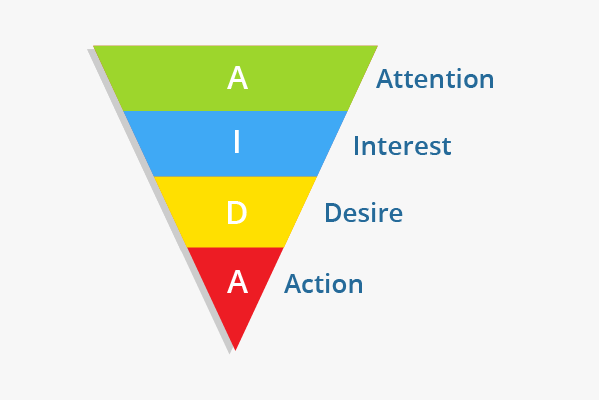
AIDA theory was developed by American advertising and sales pioneer, Elmo Lewis in 1898. He created his AIDA (Attention/Awareness, Interest, Desire and Action) funnel model on customer studies in the US life insurance market to explain the mechanisms of personal selling. Later evolutions of the theory have edited the AIDA steps and therefore, another step- satisfaction- has been added.
This theory is based on the premise that during a sales presentation, the prospect consciously goes through five different stages: Awareness/Attention, Interest, Desire, Action and Satisfaction.
1. AWARENESS/ATTENTION
The salesperson should attract the prospect to his presentation before he actually goes into the details of the same
- This is to ensure that the prospect becomes receptive to the presentation.
- Unless the salesperson involves the prospect’s mind in the presentation, his total effort
may go unnoticed or unregistered. - Drawing the prospect’s attention is important for dissociating him from other assignments and involving him in the presentation, both physically and mentally, so as to gain maximum from the sales meeting.
2. INTEREST
The salesperson should ensure that the prospect remains glued to his presentation throughout its length and that the prospect does not wander away from the same.
The salesperson should be make efforts to know the interests, likes, dislikes, attitude and motivation of the prospect and should proceed with the presentation, keeping in view all these factors.
3. DESIRE
The salesperson should consciously try to bring the prospect into this stage of readiness to the point of buying his product.
He should concentrate on projecting the benefits of his product to the prospect. He should go even to the extent of presenting benefits according to the motivation of the prospect.
For example, if the prospect is motivated more by safety need, then an insurance salesman can put stress on the safety benefits provided by the insurance plans he is offering.
4. ACTION
Once the salesperson has been successful in taking his prospect through the three stages, as discussed above, he should induce the prospects into actually buying the product.
5. SATISFACTION
The salesperson should also ensure that the delivery of the service takes place within the time frame and all other promises are kept, regarding freebies, discounts, etc. Moreover, the salesperson should try to keep in touch with his prospect and should keep enquiring about the experience of the customer with the service.